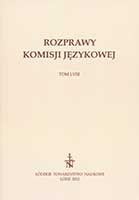Zakres wpływów obcych we współczesnej polszczyźnie północnokresowej. Wpływy litewskie
Range of foreign influences in the Polish language of Northern Borderland. Lithuanian influences
Author(s): Iryda Grek-Pabisowa, Małgorzata OstrówkaSubject(s): Language and Literature Studies
Published by: Łódzkie Towarzystwo Naukowe
Keywords: Polish language of Northern Borderland; words of Lithuanian origin; lexis
Summary/Abstract: The article is based on the material (more than 220 scientific publications over the last 85 years) prepared for print of the Dicitionary of Spoken Polish Language of Northern Borderland. Polish language is currently used by majority of Polish people in 5 areas behind the eastern border of the Republic of Poland, i.e. Eastern and Western Belarus, Vilnius and Kaunas Lithuania and in Latvia (mainly Latgale). The authors could excerpt from the lexical material slightly more than 350 lexical units adopted to the Polish grammatical system. 154 words of Lithuanian origin, i.e. 44% of the whole were recorded from inter-war works and texts which came from Vilnius repatriates. The most – 80% of borrowings come from the Vilnius district, 40% – from the Kaunas district, 14% – from the territory of Belarus, single examples – from Latvia, 23% (80 words) exist at the same time in Vilnius and Kaunas Lithuania. Only 25 lexemes (the oldest borrowings) appear simultaneously in the whole discussed area – these are terms connected with agriculture and farming – świreń/świron ‘a granary’, torp ‘a mow’, kul ‘a sheaf’, dyrwan ‘a grassy fallow’, gil ‘a gadfly’, żagary ‘dry brushwood’, szakal ‘a stick’. Borrowings connected with human mental and physical features, official and administrative terminology, physiographic names as well as numerous words of Lituanian origin unadopted (names connected with education, new rural infrastructure, auxiliary words used in utterances: bet ‘but’, jo ‘yes’, kod ‘when’) were recorded in the later period. More frequent quotes and calques in the newer material are the result of more and more popular Polish – Lithuanian bilinguism.
Journal: Rozprawy Komisji Językowej
- Issue Year: 2012
- Issue No: 58
- Page Range: 111-122
- Page Count: 12
- Language: Polish

